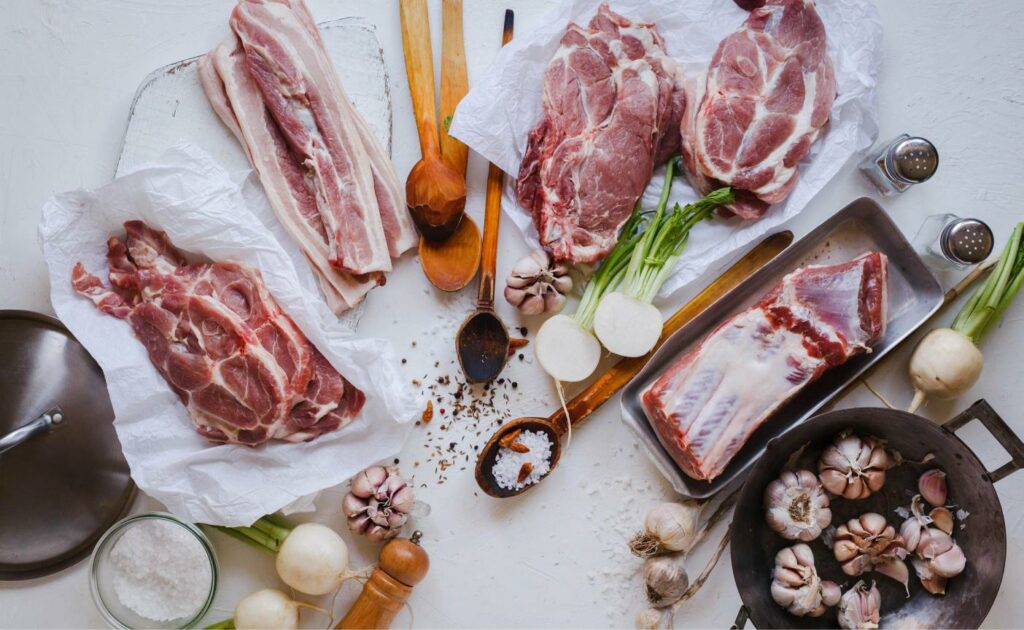The parts of the Iberian pig make this animal one of the most craved in Spanish gastronomy. Thanks to the variety of types of meat that can be obtained from the quartering of the Iberian pig, a multitude of products of the highest quality can be made.
Do you want to know which are the parts of the Iberian pig? At César Nieto we know it very well, thanks to our experience in the sector. Our company specializes in the elaboration and sale of the meat and fat of the Iberian pig.
The parts of Iberian pork parts
The Iberian pig is one of the culinary jewels of Spain and thanks to its different parts, it is an endless source of flavors and textures. A delicacy that we have at César Nieto, offering a selection of quality products to never cease to surprise us. Discover the products of César Nieto!
Iberian Ham
Undoubtedly, the most famous and appreciated part of the Iberian pig is its ham. Coming from the hind legs of the animal, the Iberian ham is slowly cured for months or even years.
Iberian whole leg
Similar to ham, the Iberian whole leg is obtained from the front legs of the Iberian pig. Although it is slightly smaller and less fatty than ham, the paleta offers an exquisite flavor and smooth texture.
Iberian loin
This part of the pig, located in the dorsal area, is known for its lean and juicy meat, which is cured and seasoned to produce the delicious Iberian loin. It is a highly prized sausage for its intense flavor and firm texture.
Iberian Pancetta
Pancetta, or bacon, is a part of the pig obtained from the belly. In the case of Iberian pork, the bacon is cured and seasoned to produce a juicy and flavorful product.
Iberian chorizo and salchichón
These cold cuts are made from the lean meat of the Iberian pig, combined with spices and seasonings.
Iberian pork pluma
The Iberian pork pluma is a cut found in the upper part of the loin, near the neck. It is a lean and tender meat, with a fat infiltration that gives it an exceptional flavor. Iberian pluma is highly valued for its juiciness and its ability to absorb the flavors of marinades and spices.
Everything you should know about the Iberian pig
The Iberian pig is a breed of pig native to the Iberian Peninsula, known for its dark skin, elongated snout and droopy ears. It is distinguished by its ability to accumulate a large amount of intramuscular fat, which gives it its characteristic flavor and juicy texture.
During the rearing of the Iberian pig, the animals are fed on acorns and grasses in the dehesas, which contributes to its unique flavor and quality. This natural fattening process and the acorn-rich diet are fundamental to the development of the Iberian pig’s flavor.
Therefore, the Iberian pig offers a wide range of products as we have already named and each one has its own elaboration and distinctive characteristics, but they all share the flavor and quality of the Iberian pig.
In addition, hams and cured meats derived from the Iberian pig undergo a curing and maturation process that can last several months or even years. During this time the products are hung in natural cellars where their unique aromas and flavors develop thanks to the action of bacteria and specific climatic conditions.
In short, the Iberian pig is a central element of its gastronomic culture. The tradition of pig slaughtering and the artisanal production of pork products is a practice rooted in many regions of the country and passed down from generation to generation.
Traditions that we keep very present in César Nieto, representing the culinary excellence and the artisan tradition of Spain. Come and buy the part of the Iberian pig you like the most. It will be a delicacy for your senses.
